Qualifi
Conceptual · Hybrid
Capstone Project
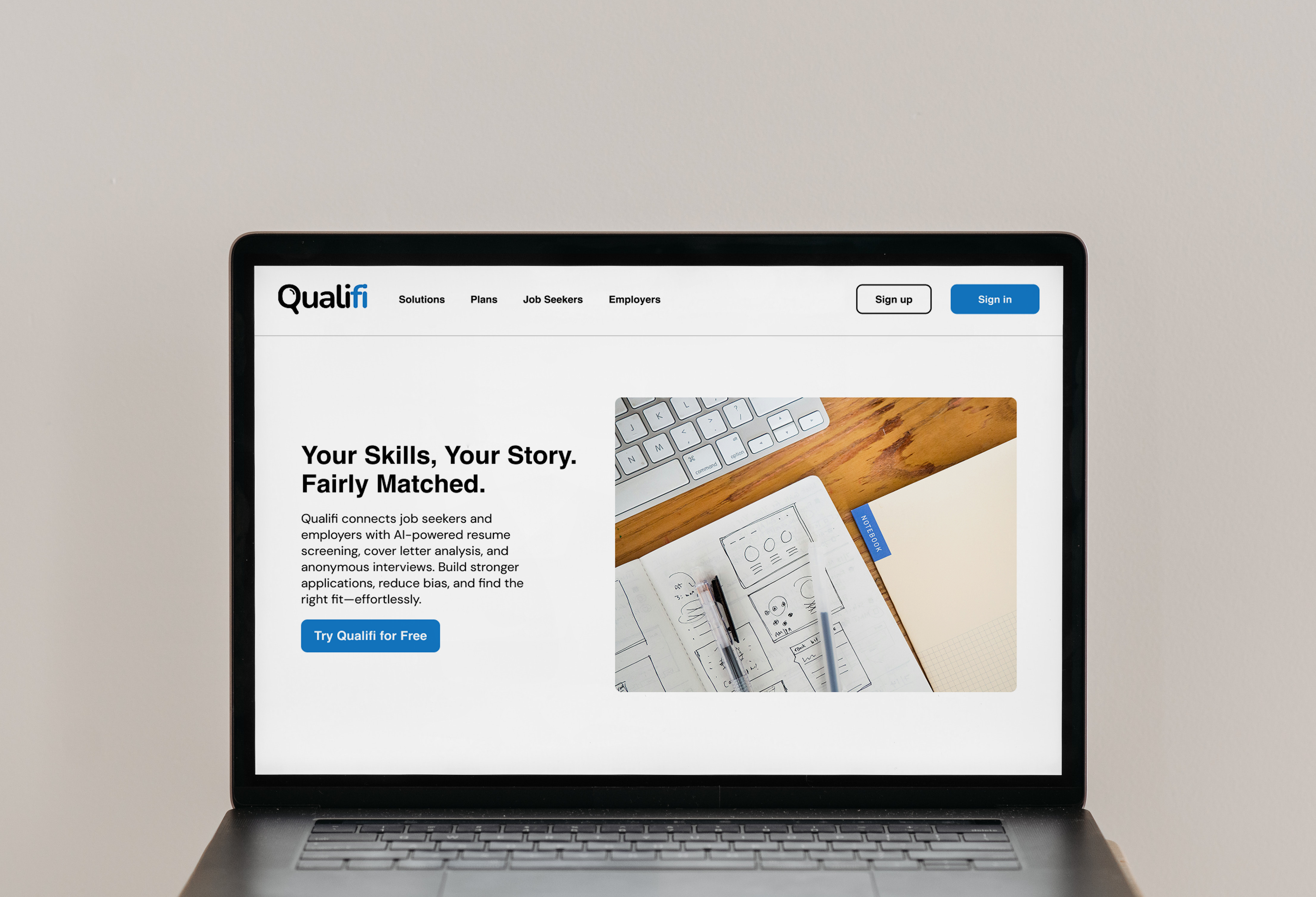
Roles
UX Researcher
UI/UX Designer
Business Developer
Timeline
4 months
Dec 2024 – Apr 2025
Tools
Figma
Team of 4
(overlapping roles)
4 UX Researchers
3 UI/UX Designers
3 Business Developers
Deliverables
2 Proposals (Research & Entrepreneurship)
2 Prototype Video Demos (MVP & Final)
2 Reports (MVP & Final)
2 Live Presentations
Role
UX Researcher
UI/UX Designer
Business Developer
Timeline
4 months
Dec 2024 – Apr 2025
Tools
Figma
Team of 4
(overlapping roles)
4 UX Researchers
3 UI/UX Designers
3 Business Developers
OutPut
2 Proposals
2 Prototype Video Demos
2 Reports
2 Live Presentations
Executive Summary
Qualifi is a conceptual service platform that combats bias in hiring by anonymizing applications and training employers to recognize bias throughout recruitment. Developed over four months with a multidisciplinary team, the platform integrates bias-aware design tools, AI analytics, and training modules into one cohesive experience.
Through multiple testing rounds:
- 85% of participants valued the unified dashboard for its efficiency.
- 91% rated navigation as intuitive with minimal onboarding.
- 70% engaged first with candidate analytics, validating its central role.
- UI refinements improved task completion by 25%, revealing stronger engagement after visual prioritization updates.
By blending inclusive design principles with business feasibility, Qualifi demonstrates how ethical technology and user-centered design can align to build fairer hiring systems, empowering candidates and companies alike.
Takeaways
Building Trust Through Transparency
Every design decision was grounded in clarity: showing how resumes were anonymized and how decisions were made to foster trust between job seekers and employers.
Designing for Two Distinct Audiences
Creating parity between recruiter and job seeker experiences required balancing efficiency with empathy to ensure inclusivity without adding friction.
Bridging Digital and Physical Worlds
The Qualifi Bot demonstrated how inclusive design can extend beyond screens by meeting users in spaces where access truly matters.
This project reinforced that product design isn’t just about usability, it’s about equity, accessibility, and designing systems that give every person an equal chance to succeed.
Overview
Qualifi is a conceptual digital platform designed to reduce racial and ethnic bias in recruitment by anonymizing applications and embedding bias-aware tools across the hiring process. Developed as part of the 2025 Student Service Design Challenge under the theme “Empowering society to overcome bias,” our team sought to make hiring fairer by helping employers find the most qualified candidates, based purely on skill, not identity.
Problem
Despite growing awareness and DEI initiatives, hiring discrimination remains pervasive. Research in 2024 showed that applicants with white-sounding names received 24% more callbacks than equally qualified Black applicants.
Existing anti-bias tools often focus on resume redaction, leaving other stages like cover letters, job descriptions, and interviews vulnerable to bias.
Our challenge: How might we create an all-in-one hiring platform that helps employers and job seekers navigate the process free of bias?
Solution
Qualifi is an end-to-end hiring platform that anonymizes job applications, offers bias-detection tools for employers, and supports both sides of the hiring process through training and inclusive design.
By merging research, UX design, and AI-driven bias detection, Qualifi empowers companies to hire fairly, while allowing job seekers to be recognized for their true skills.
Research
We began by exploring bias from both sides of the hiring process.
Primary Research
- 10 job seekers (ages 21–24) surveyed
- 5 in-depth interviews (1 job seeker, 4 hiring managers)
Initial insights revealed that while job seekers were acutely aware of bias, the most influential change needed to come from hiring managers. This reframed our solution from being job-seeker-focused to serving employers first, to ensure change at the systemic level.
Key Findings
- Bias most often occurs during early screening based on names, photos, or affiliations.
- False inclusivity is common, many organizations underestimate their own bias.
- Bias often begins unconsciously. Hiring managers admitted that “fit” was a frequent but subjective factor.
- Employers seek tools to train hiring teams and audit their own processes.
- Job seekers crave transparent, feedback-based systems to understand rejections.
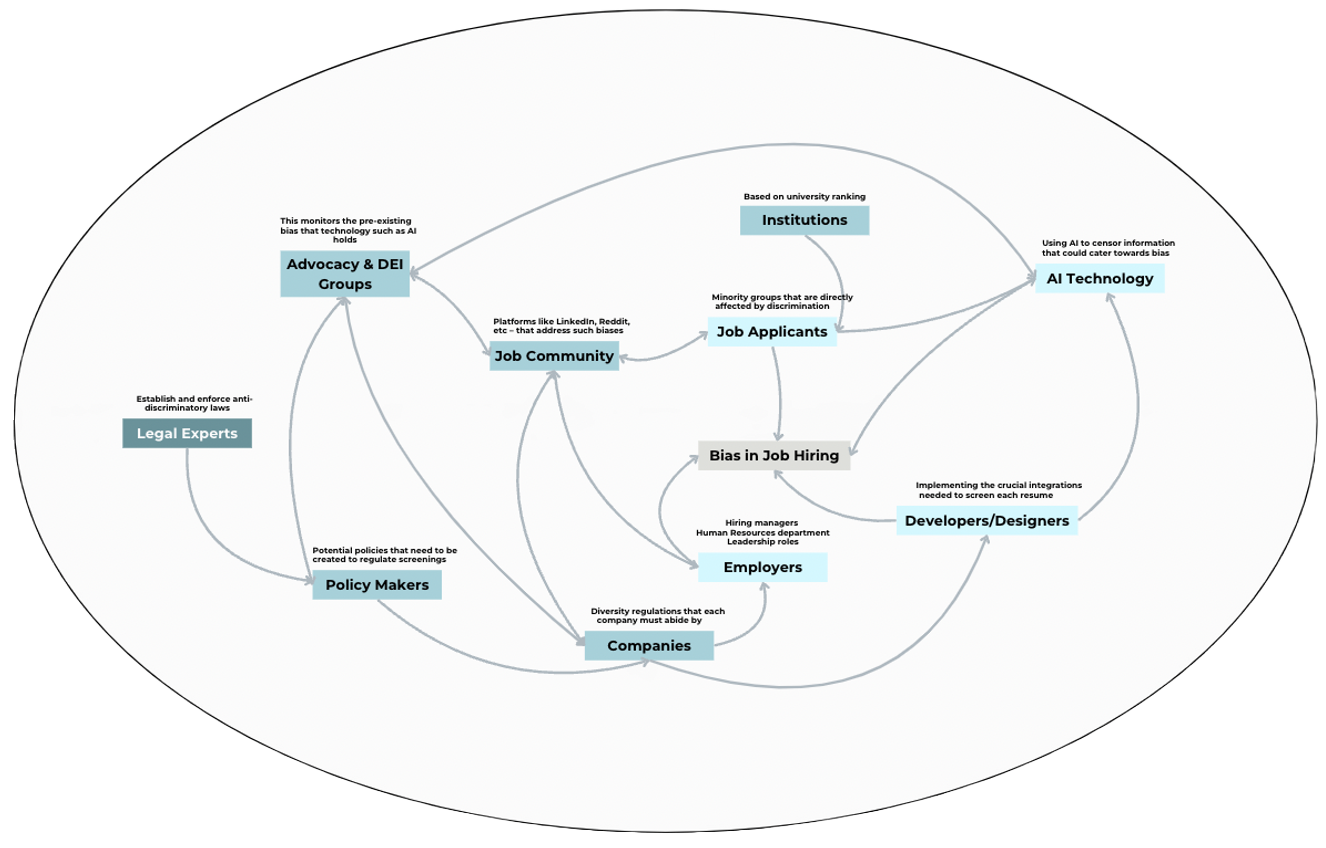
After conducting initial user tests, we were able to start designing what we wanted Qualifi to look like and developed it accordingly based on feedback we received from mentors.
- Racial bias has become covert now: Over the past 30 years approximately, there has been no change in the level of hiring discrimination however it has transformed into something more subtle and disguised. (Quillian et al., 2017).
- Resumes of minority groups get 30-50% fewer callbacks compared to resumes of white applicants not only in America but in Canada as well. When identifi able information is less obvious then the callbacks for minority groups increase (Kang, 2017).
- Bias in job hiring most commonly occurs during the initial screening stages when hiring managers can screen applicants’ resumes for information that could potentially indicate that the applicant is a non-white person (Barber, 2024).
- People rarely see themselves as part of the problem, and this often leads to false inclusivity in organizations (Jana & Diaz, 2018a).
- A 3-theory framework that includes taste-based, screening, & complementary production discrimination explores how same-race and cross-race workers fare in their productivity and efficiency. (Benson et al.,2023).
Before Pivot:
- Users mistook our early prototype for a job tracking site, not a bias-mitigation tool.
- The purpose: “empowering fair hiring” wasn’t visually or verbally clear enough.
- Job seekers wanted personalization, while employers wanted workflow efficiency.
After Pivot:
- We redesigned the interface from a job seeker-first to a recruiter-first perspective, ensuring the system addressed bias where it begins: in hiring decisions.
- Simplicity of the prototype: The user was able to easily navigate through the prototype and admired the simplicity of the design, making it easier to follow and intuitive.
- Positive task user testing: The user was given the task of “posting a job” on the job board and was able to go through the different steps of filling out the job details and posting it on the job board for applicants.
- Training modules: Post-testing, it was revealed to the user that the website participates in providing an ethnic and racial bias-free workplace, which allowed them to show their enthusiasm about the change this feature can bring to hiring practices.
- Testimonies and Partnerships: The user suggested that the first page of the prototype can have testimonials and partnerships from companies such as Workday can be included to show credibility and previous experiences from companies.
Ideation
Through competitor analysis (Blendoor, RChilli Redact & Design), we discovered a major gap: existing solutions only addressed parts of the problem and served employers exclusively.
We envisioned Qualifi as an integrated ecosystem. A platform that:
- Supports both employers and job seekers.
- Embeds bias-mitigating tools at every touchpoint.
- Connects digital and physical experiences for accessibility and trust.
Low-Fidelity Prototype
We created early wireframes to test usability and validate user flow clarity for both employers and job seekers.
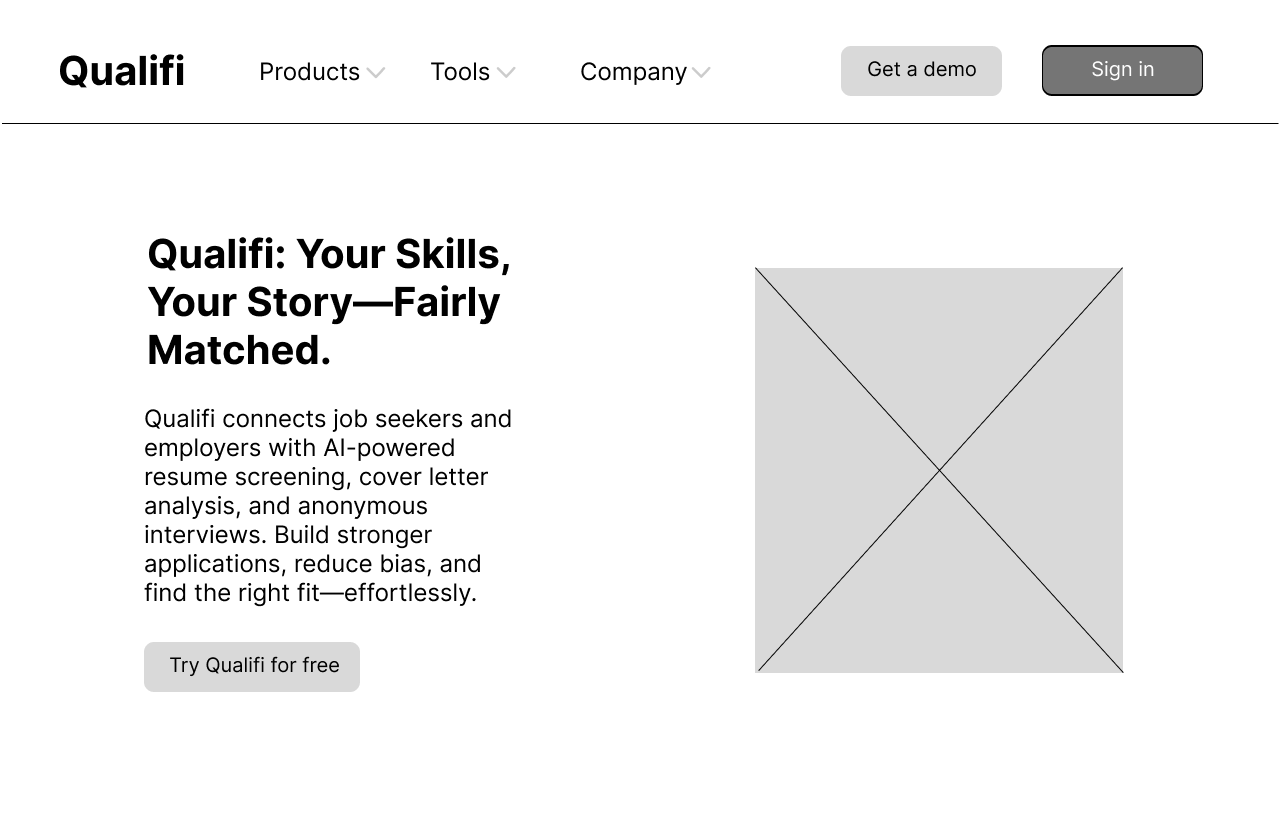
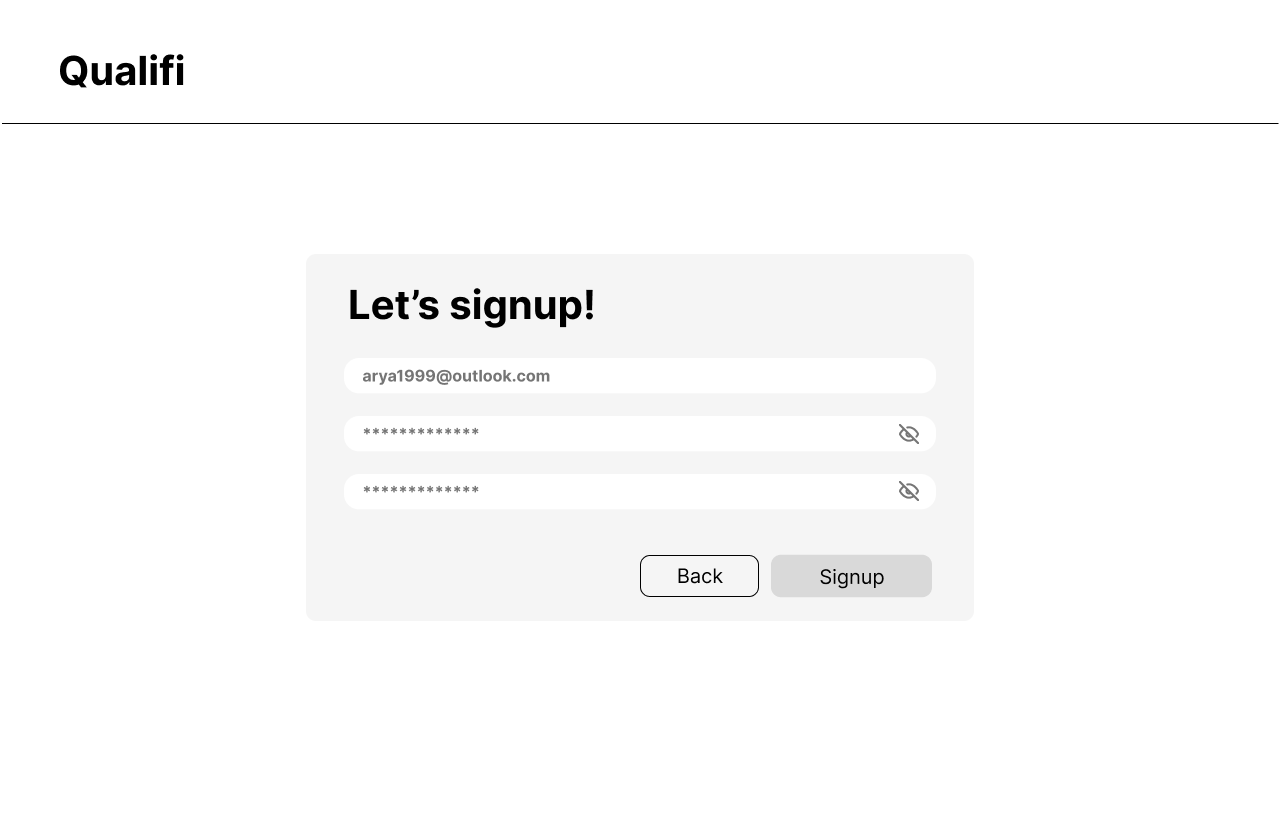
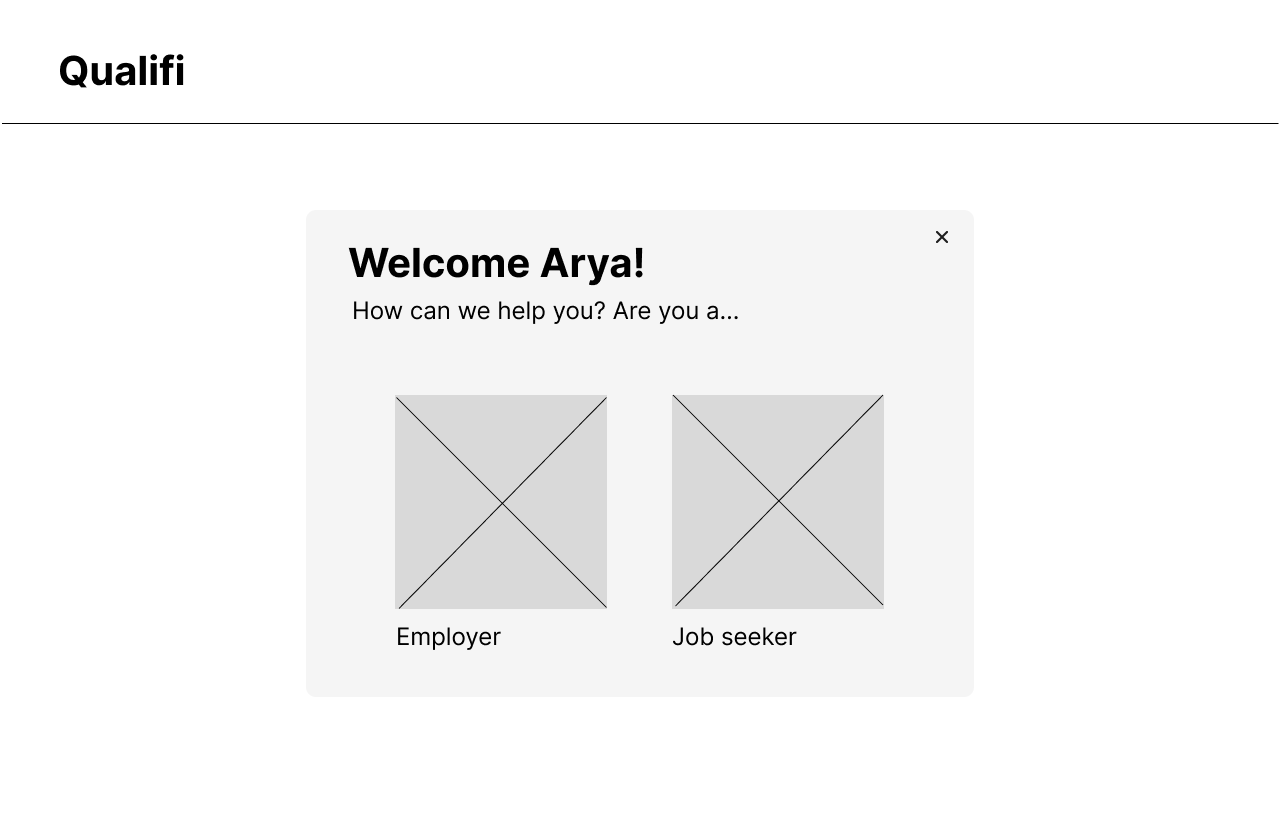
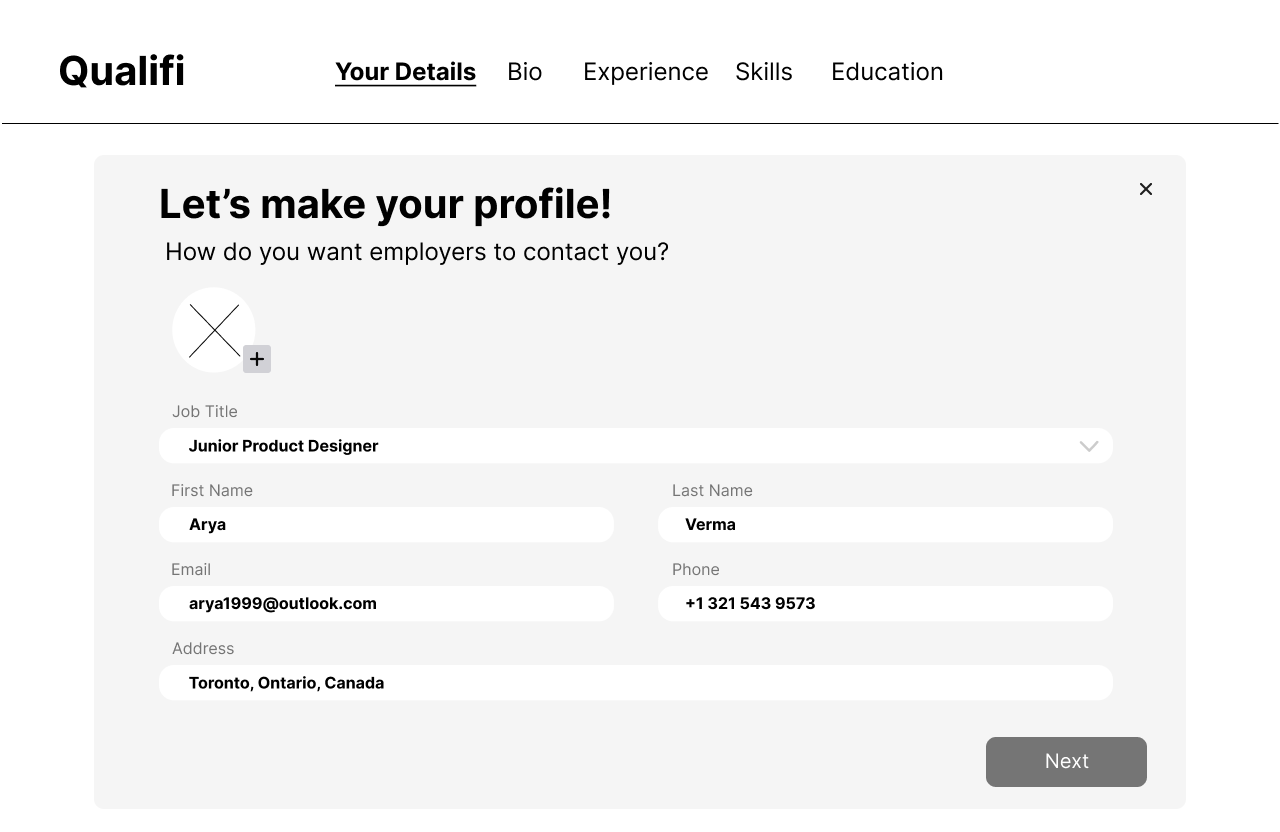
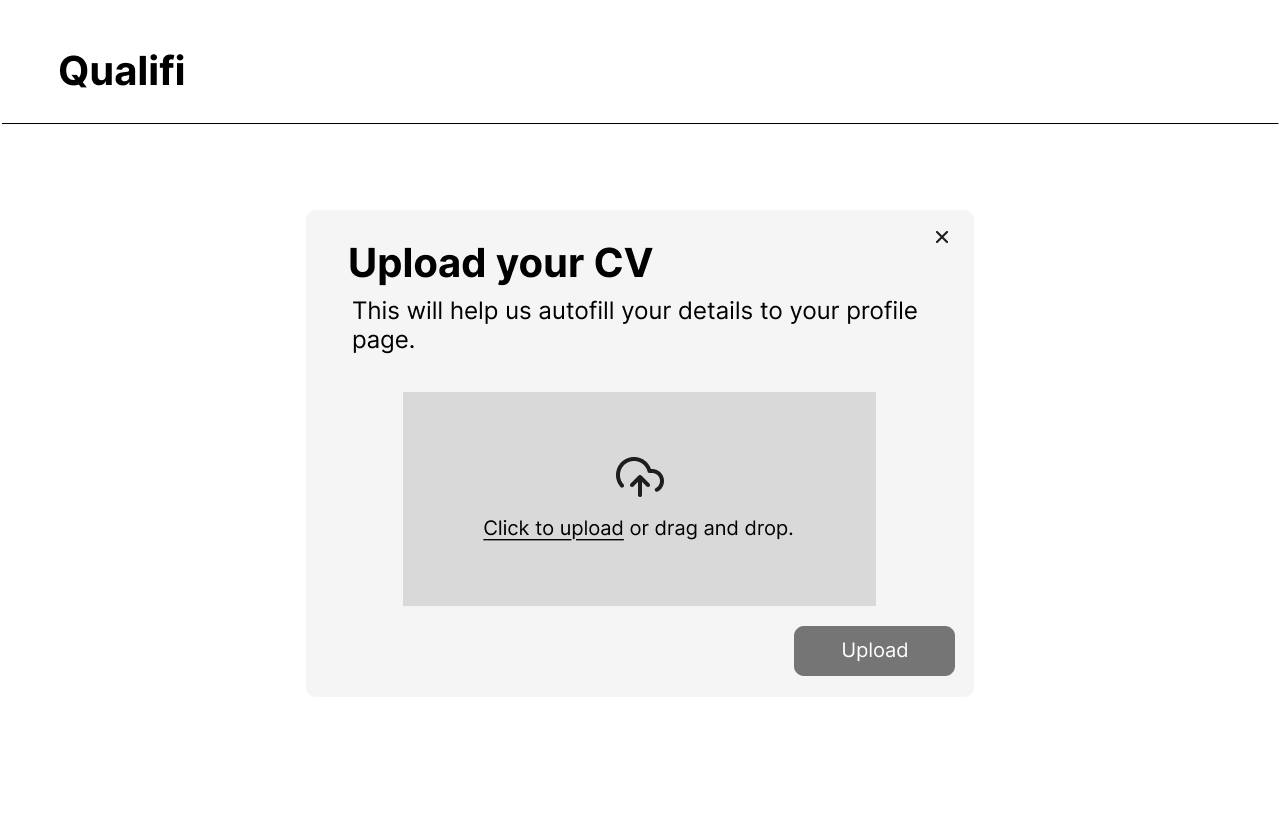
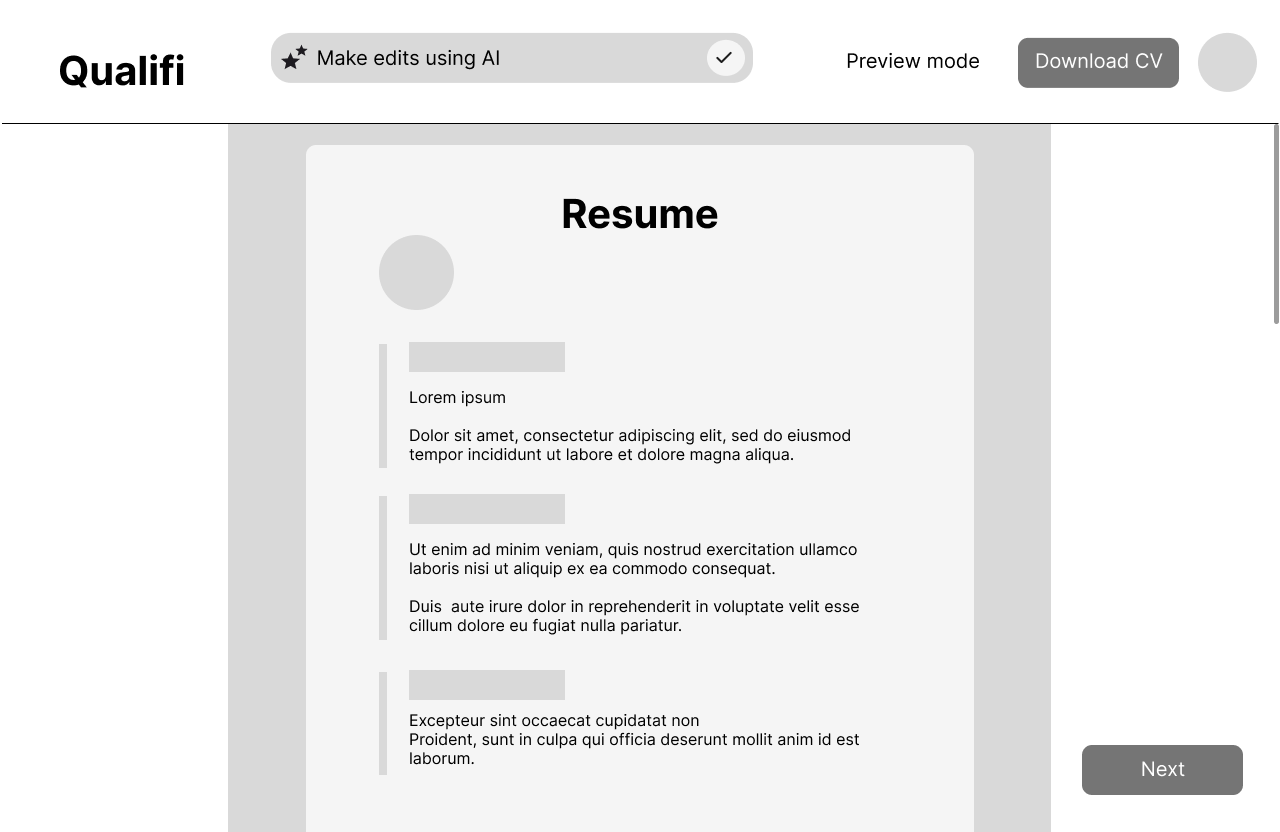
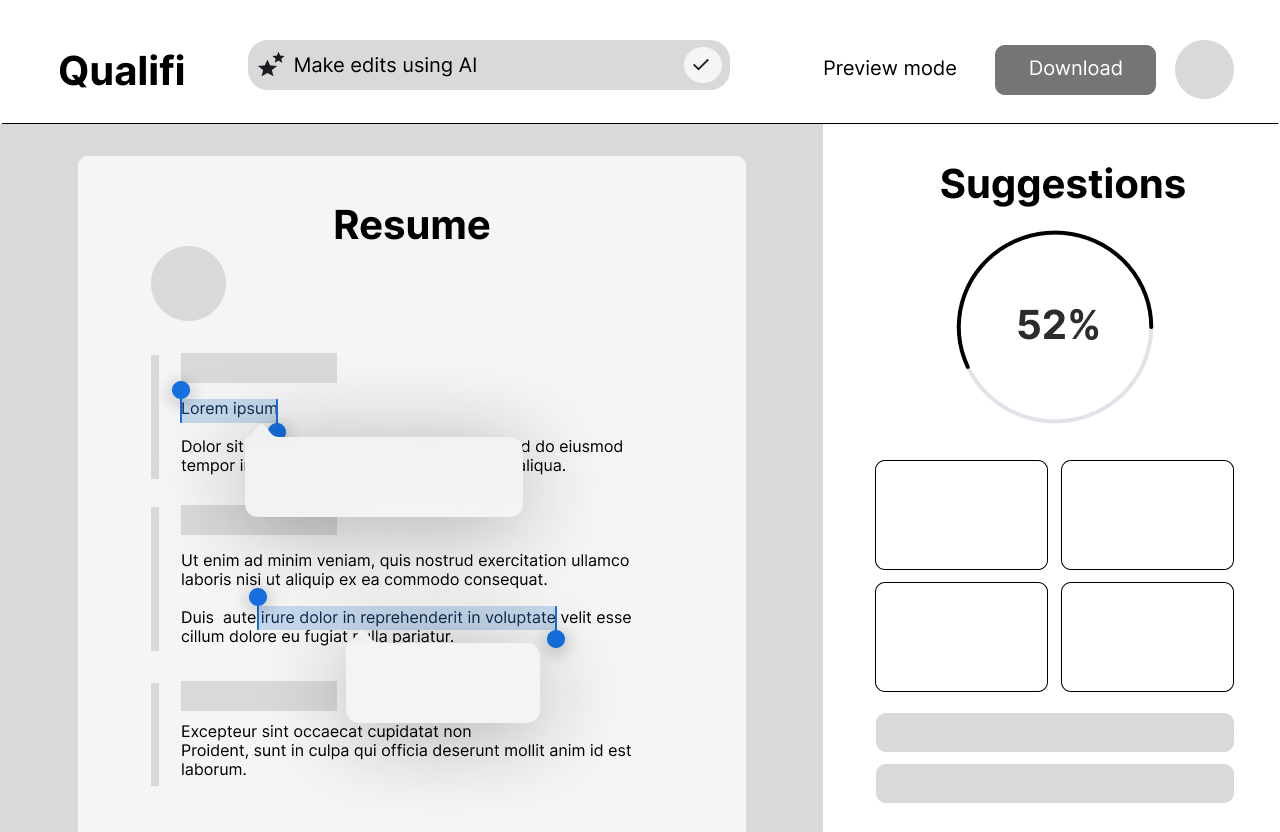
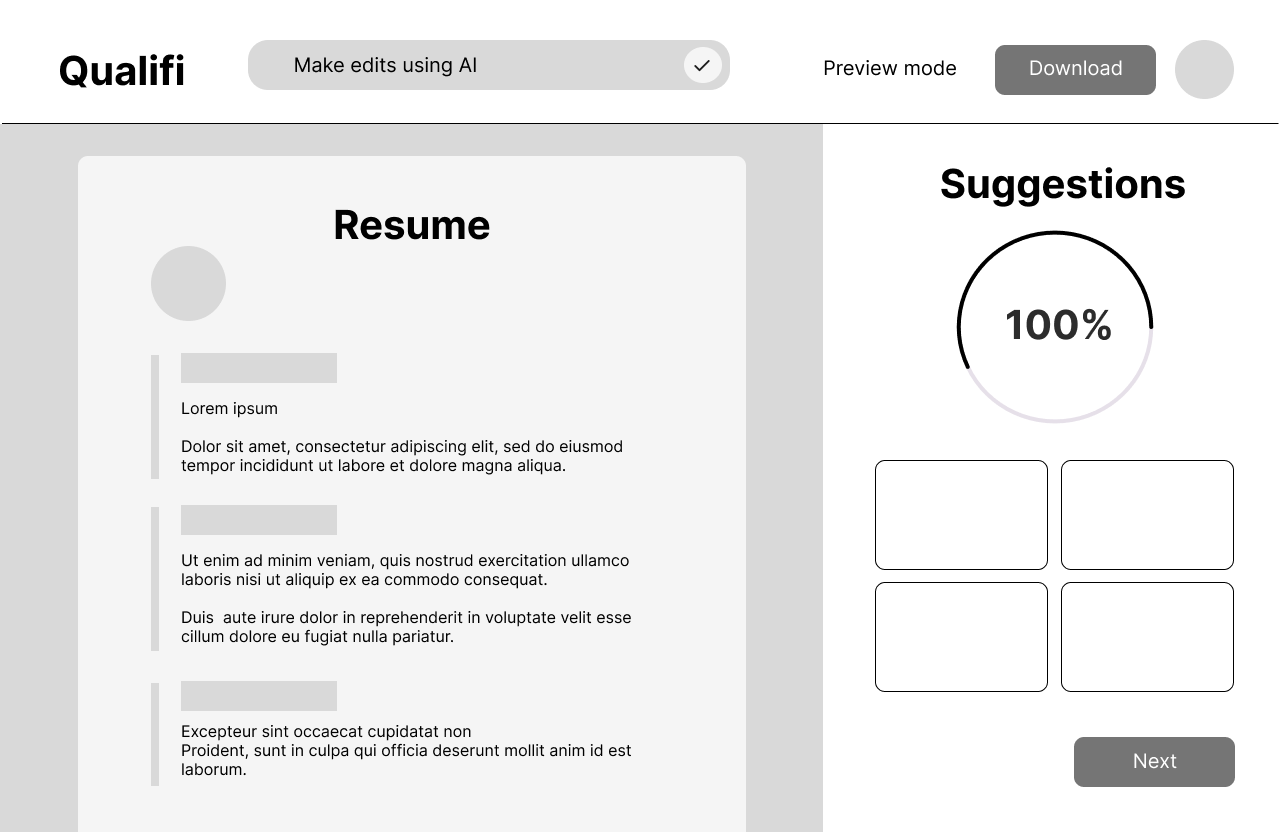
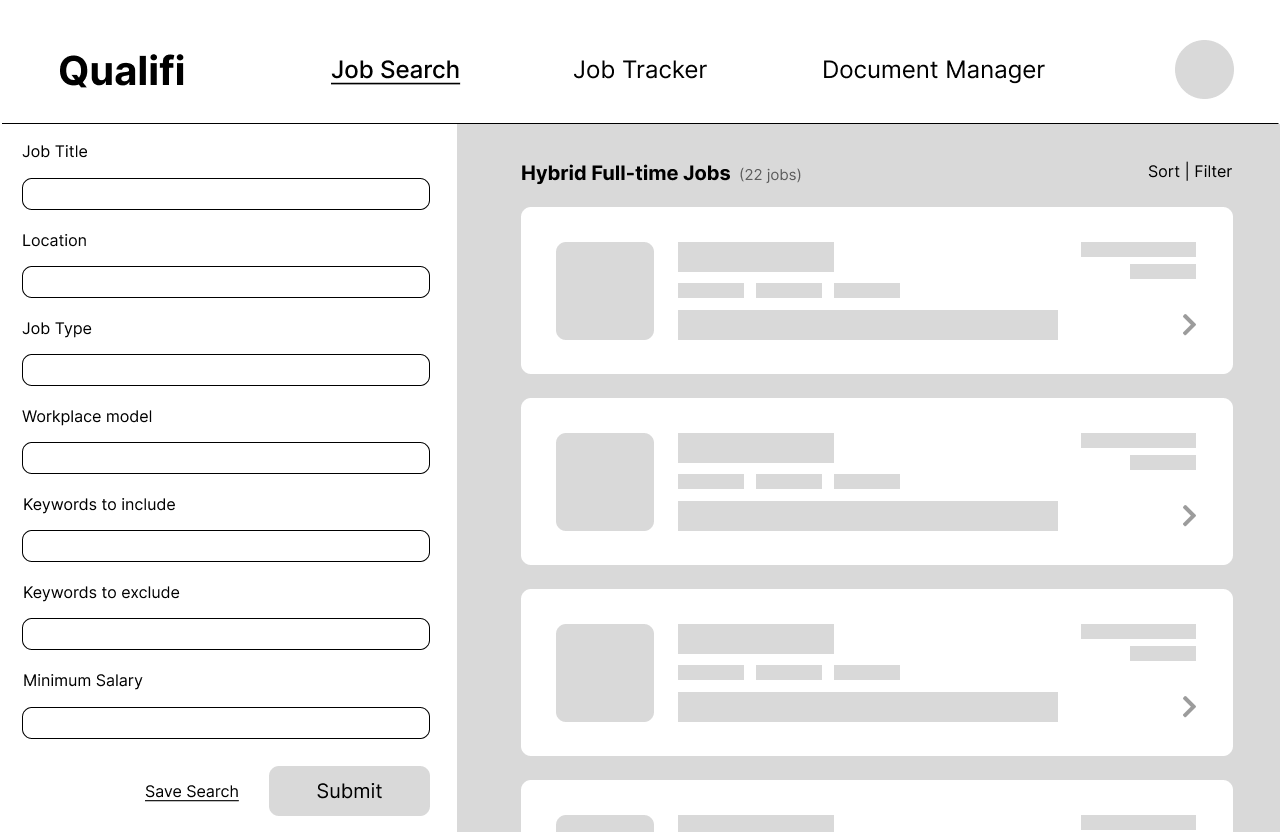
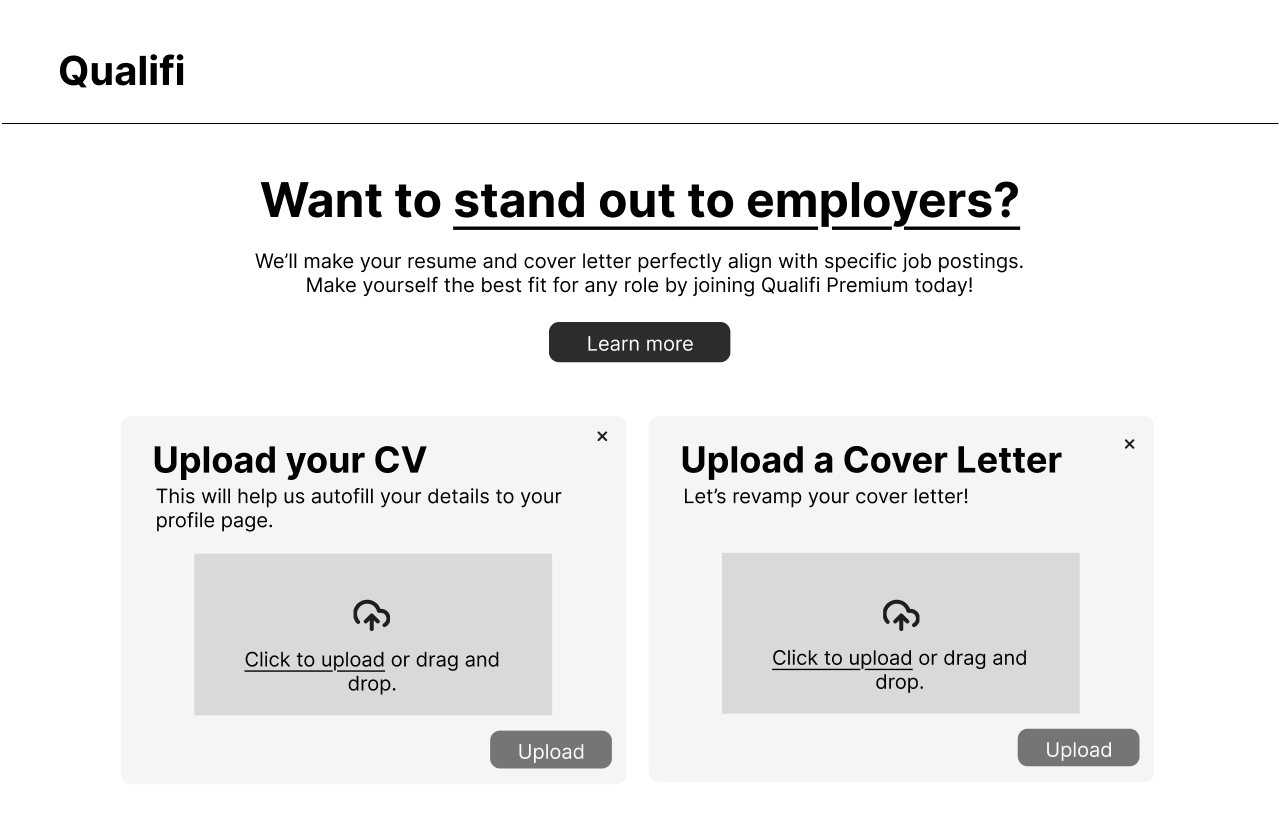
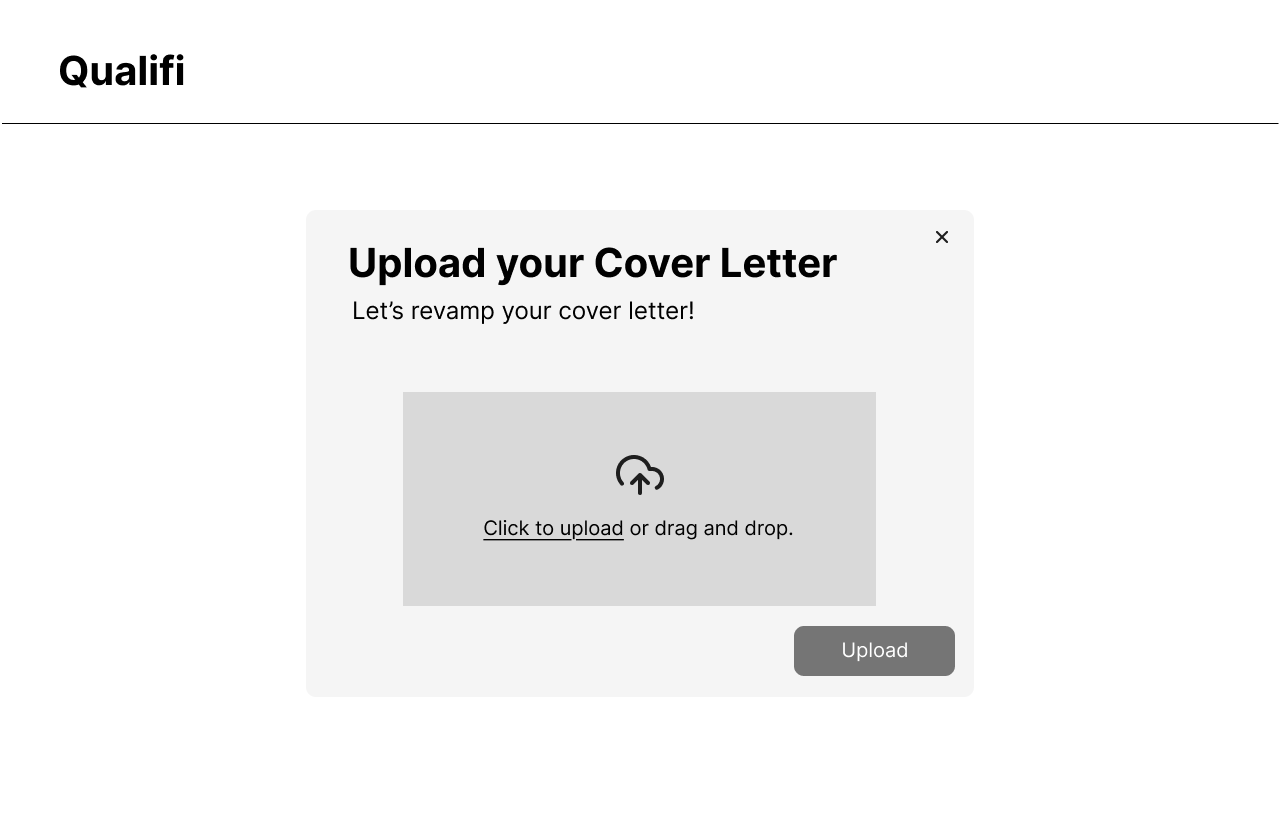
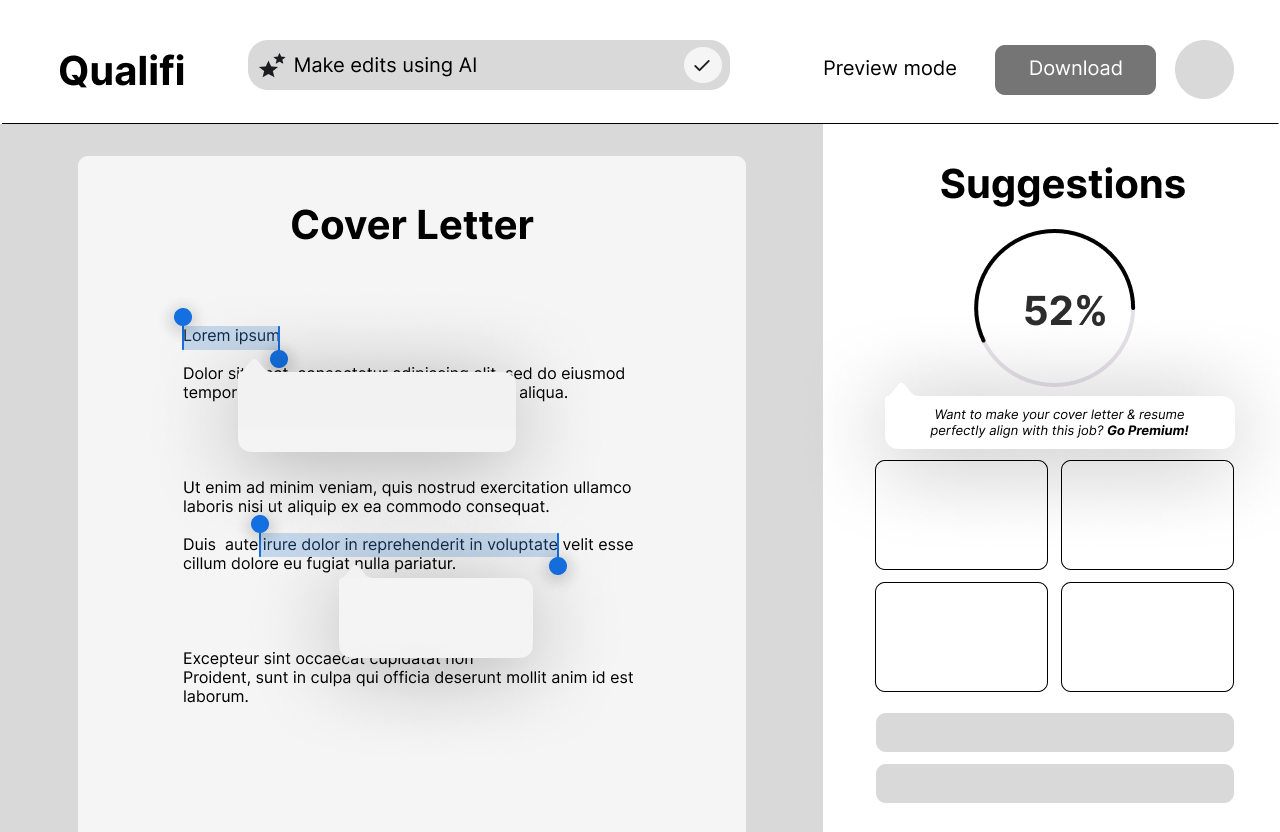
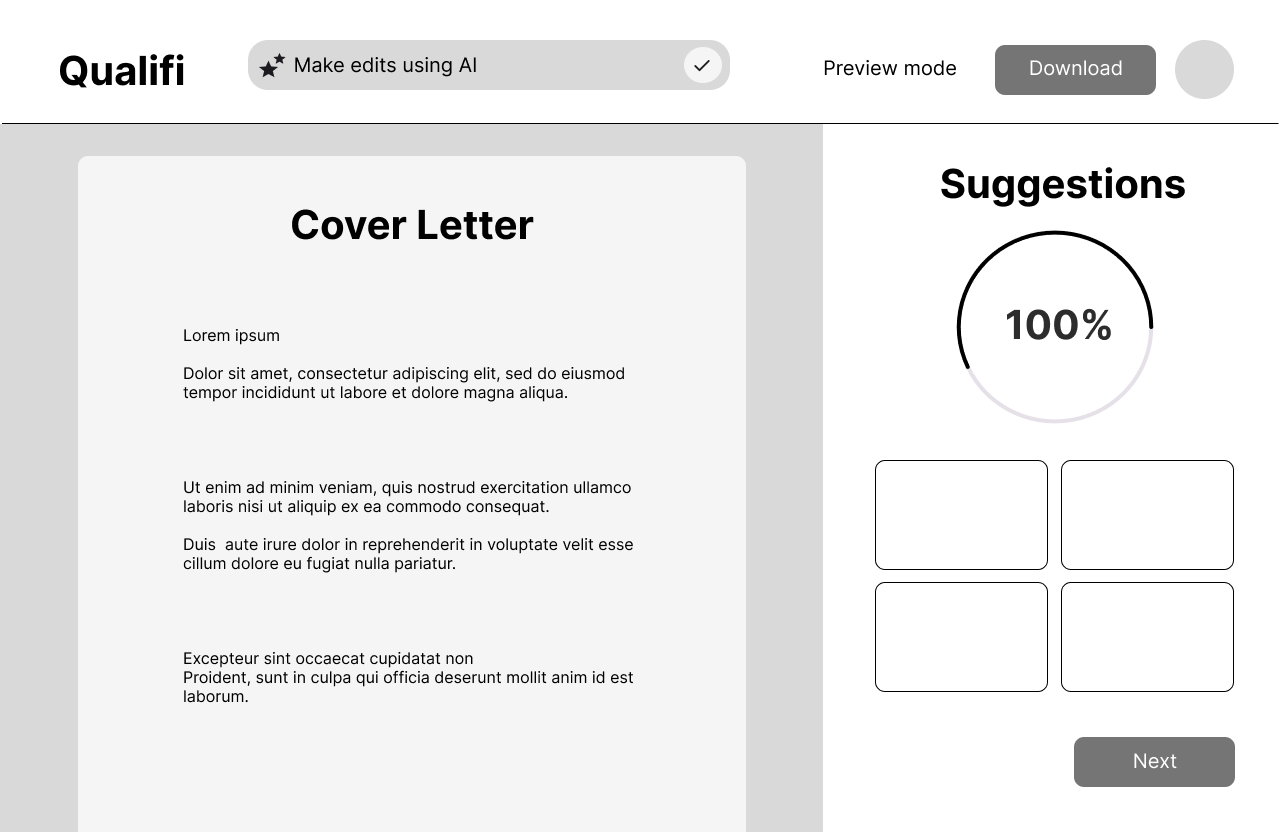
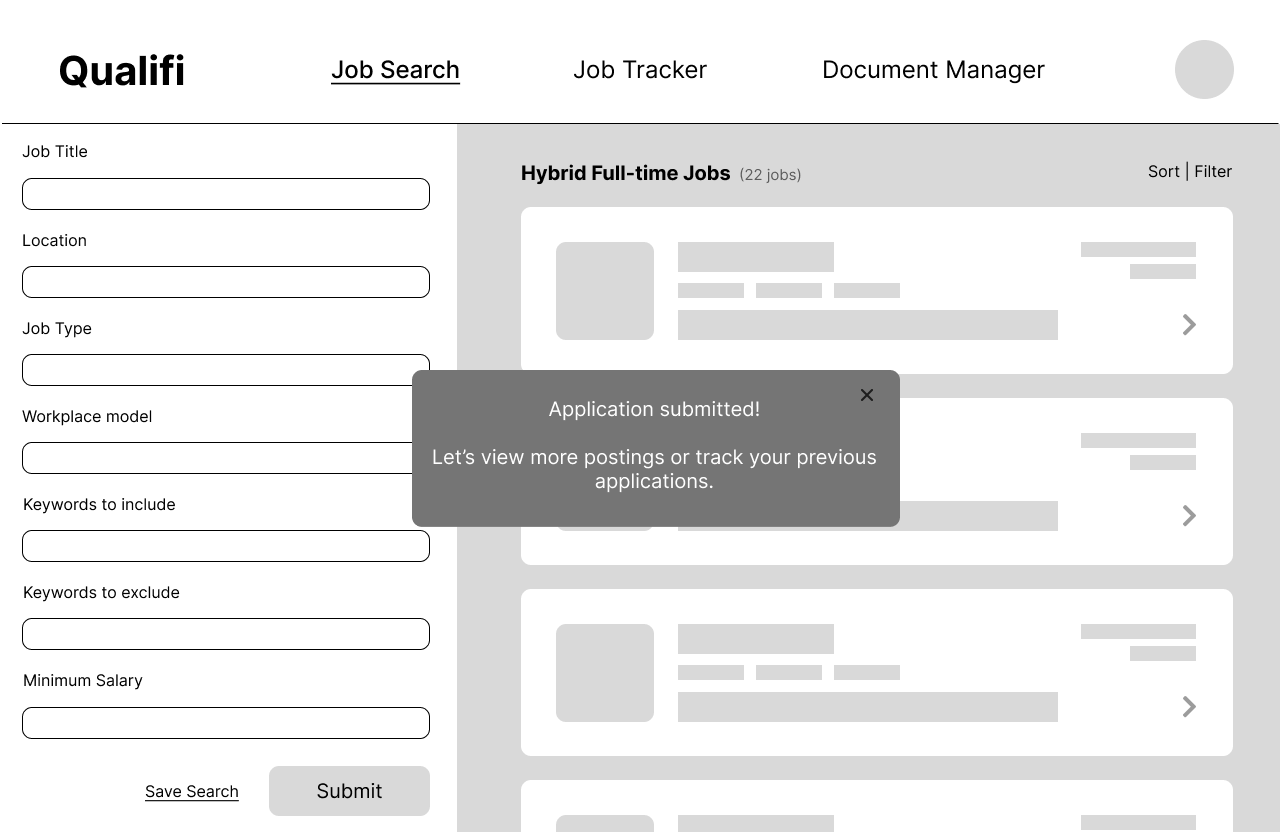
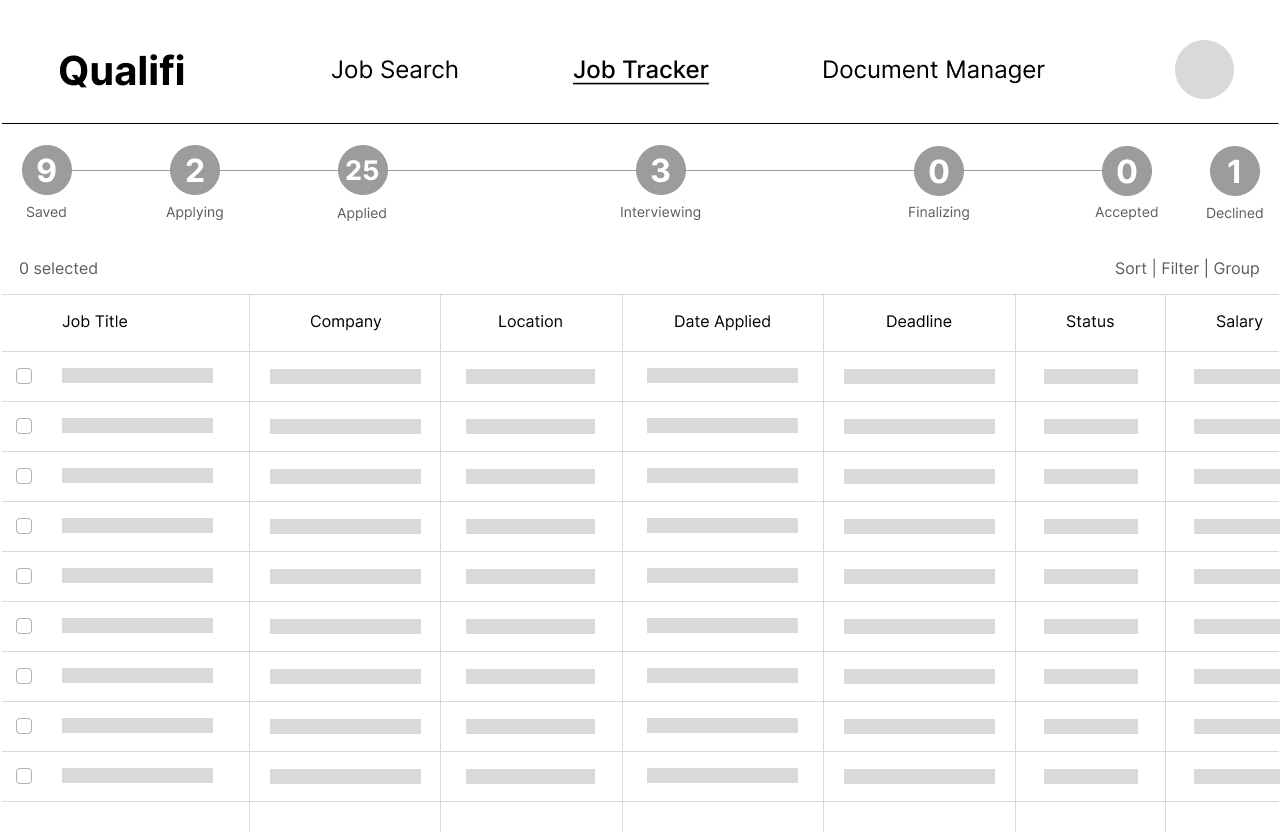
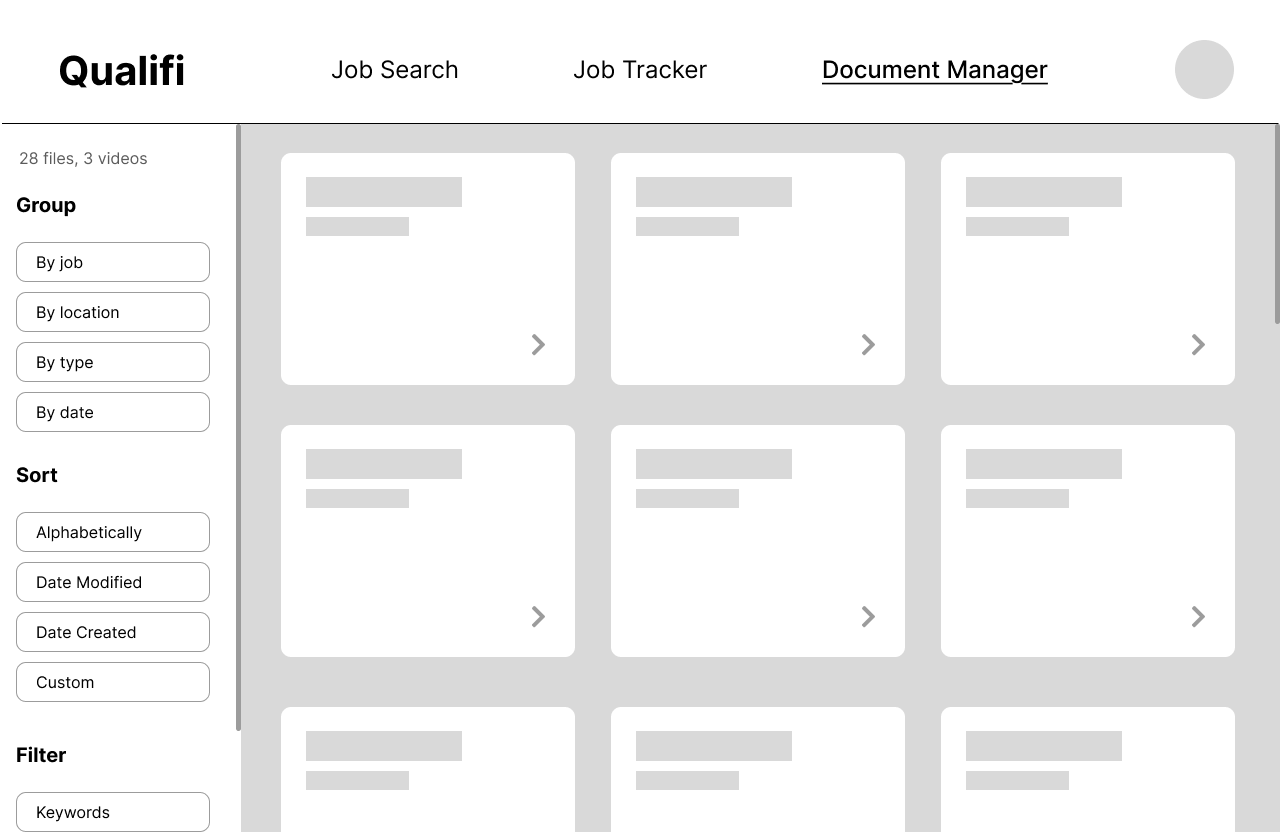
Final Design
Our final design demonstrates an inclusive, transparent hiring flow supported by AI-assisted features:
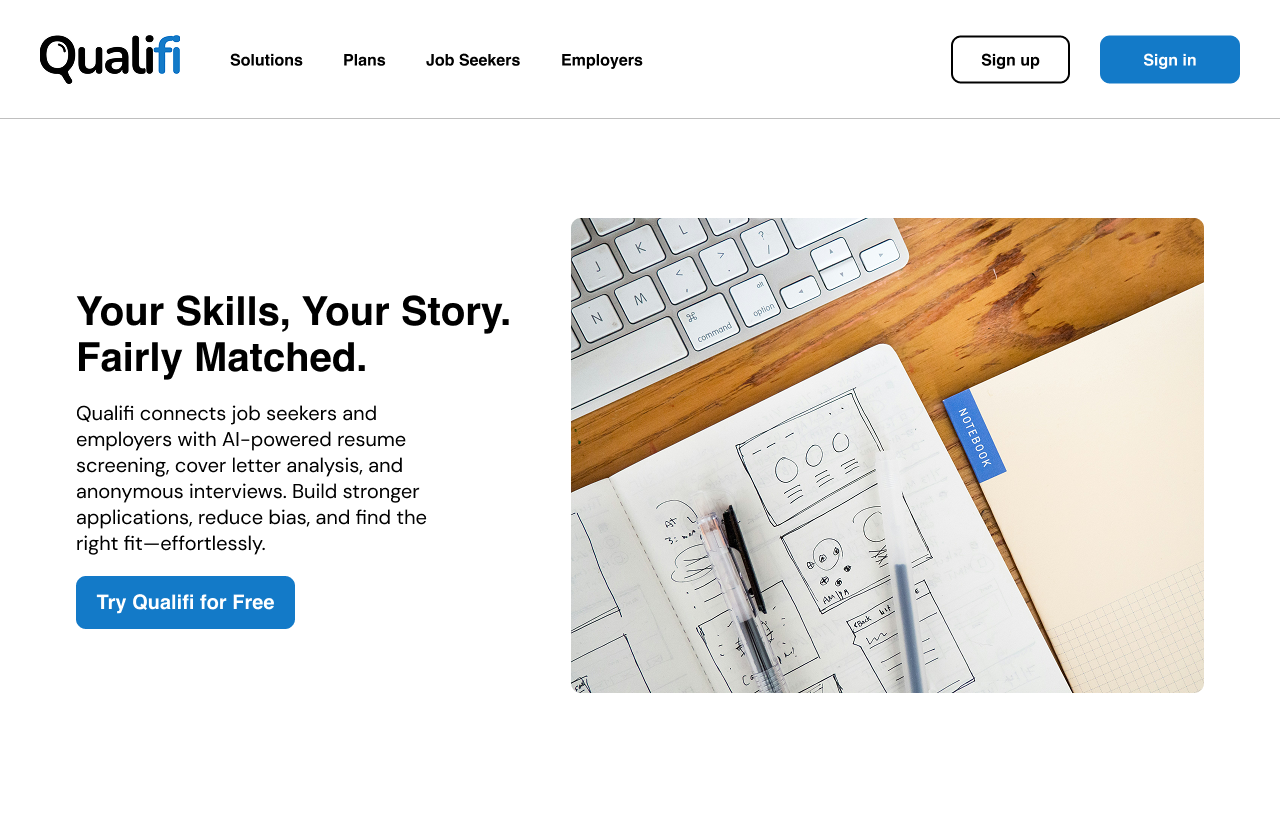
Features Highlight:
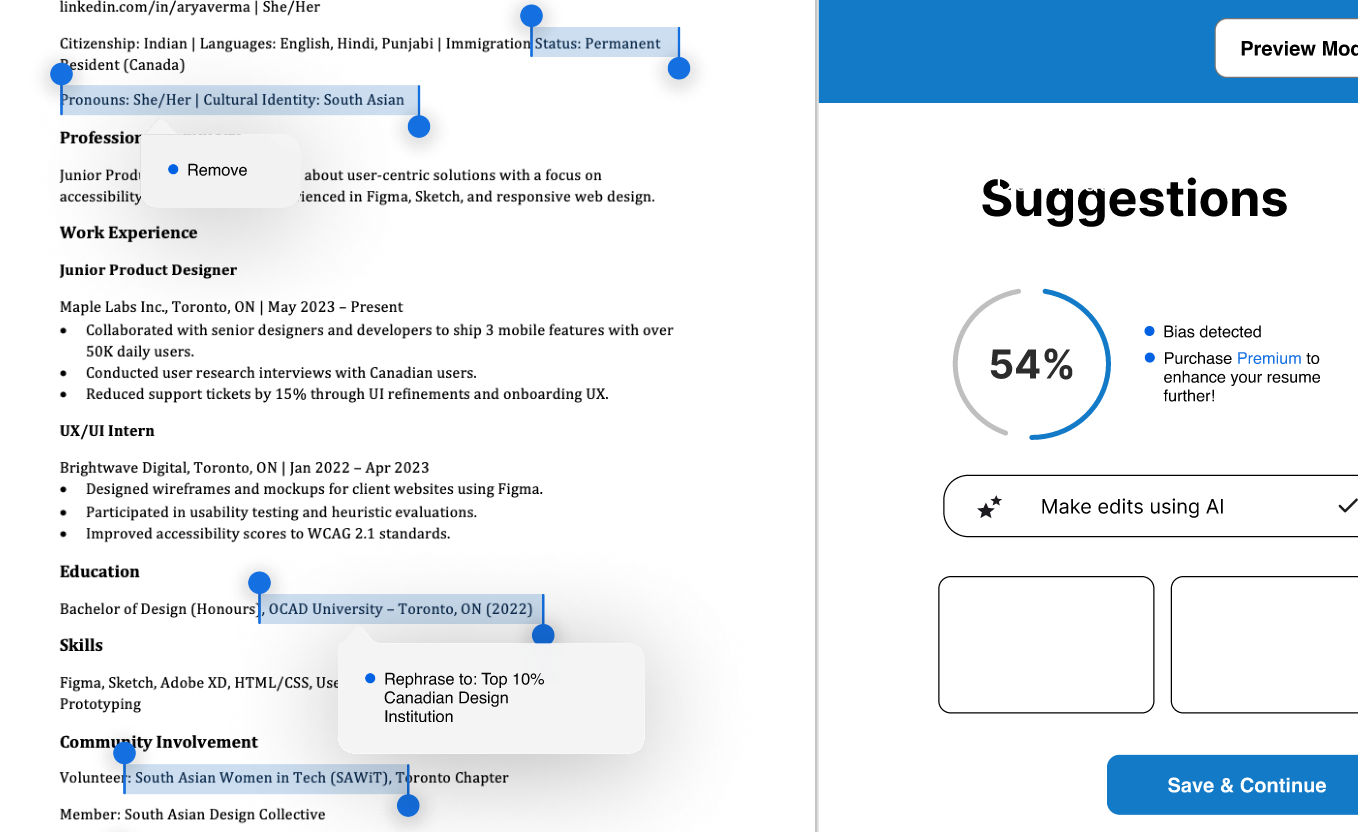
Bias-aware Scanner
Provides instant, real-time feedback as job seekers upload resumes or cover letters, highlighting and removing identity cues.
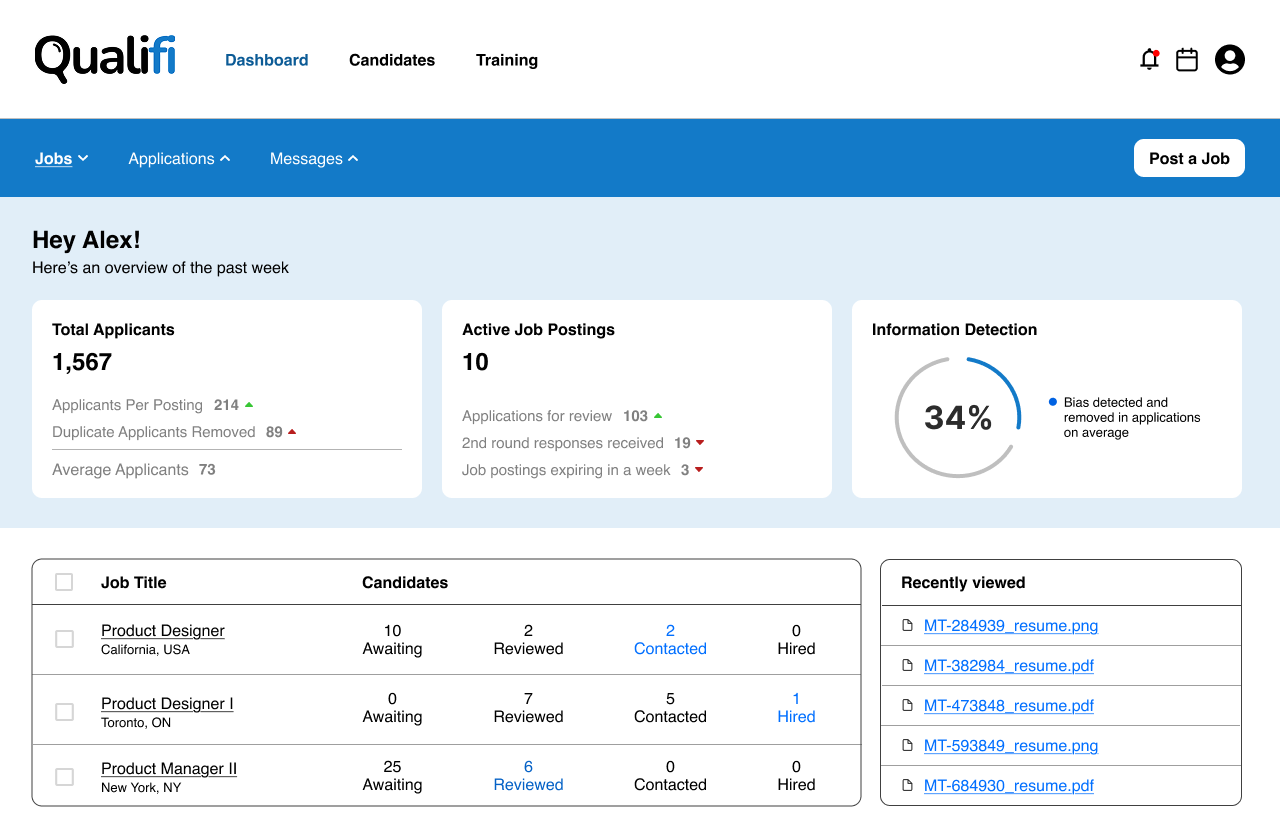
Employer Dashboard
Central hub for recruiters to manage postings, view anonymized applications, and access hiring analytics.
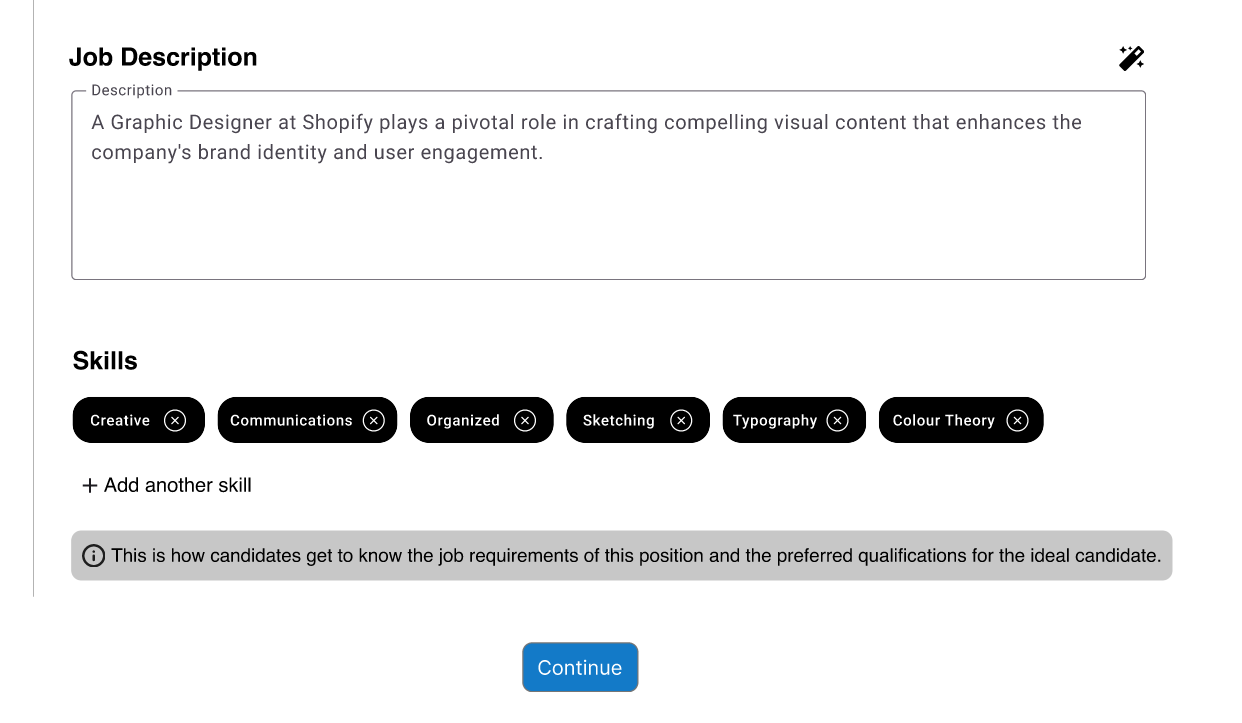
Inclusive Job Description Tool
AI-powered writing assistant that helps employers use skill-based and inclusive language in postings.
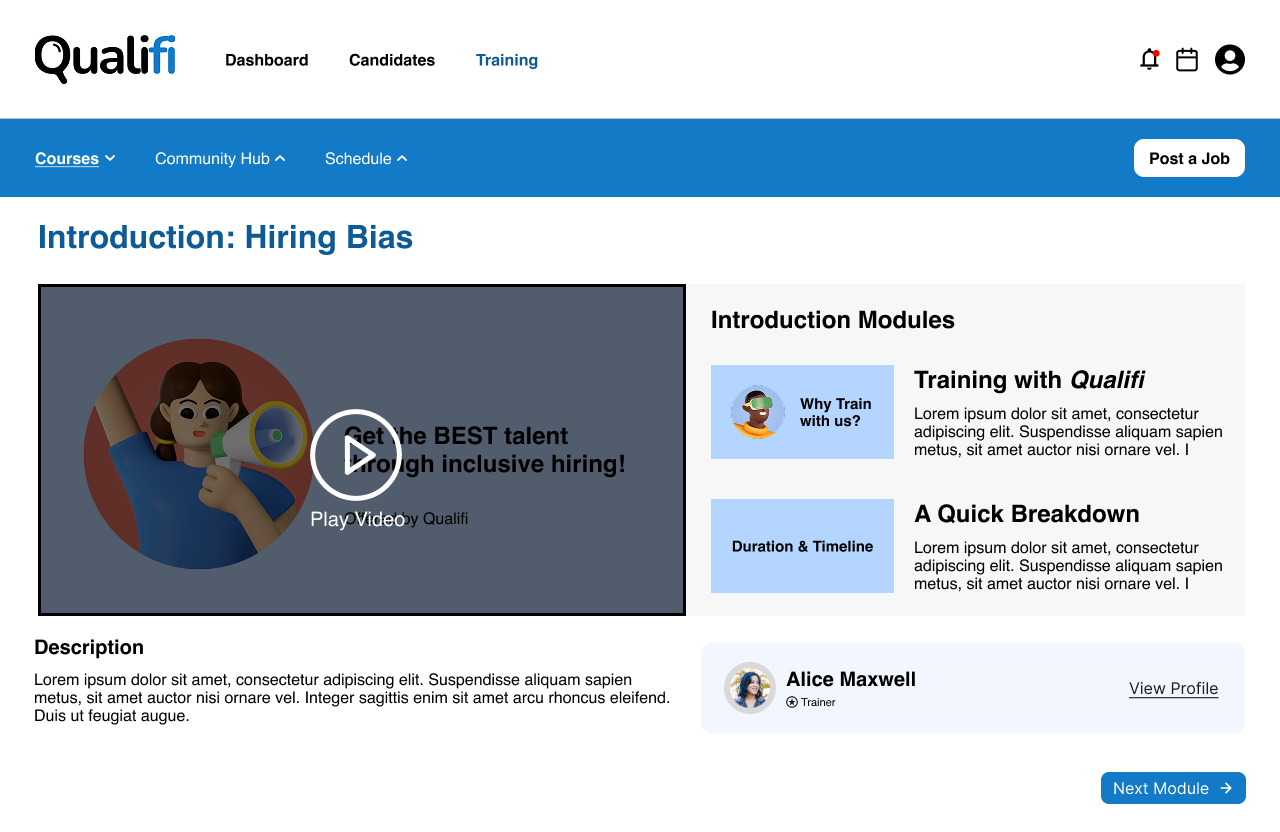
Employer Training
A built-in micro-learning module offering guidance on how bias manifests during recruitment and strategies to reduce it.
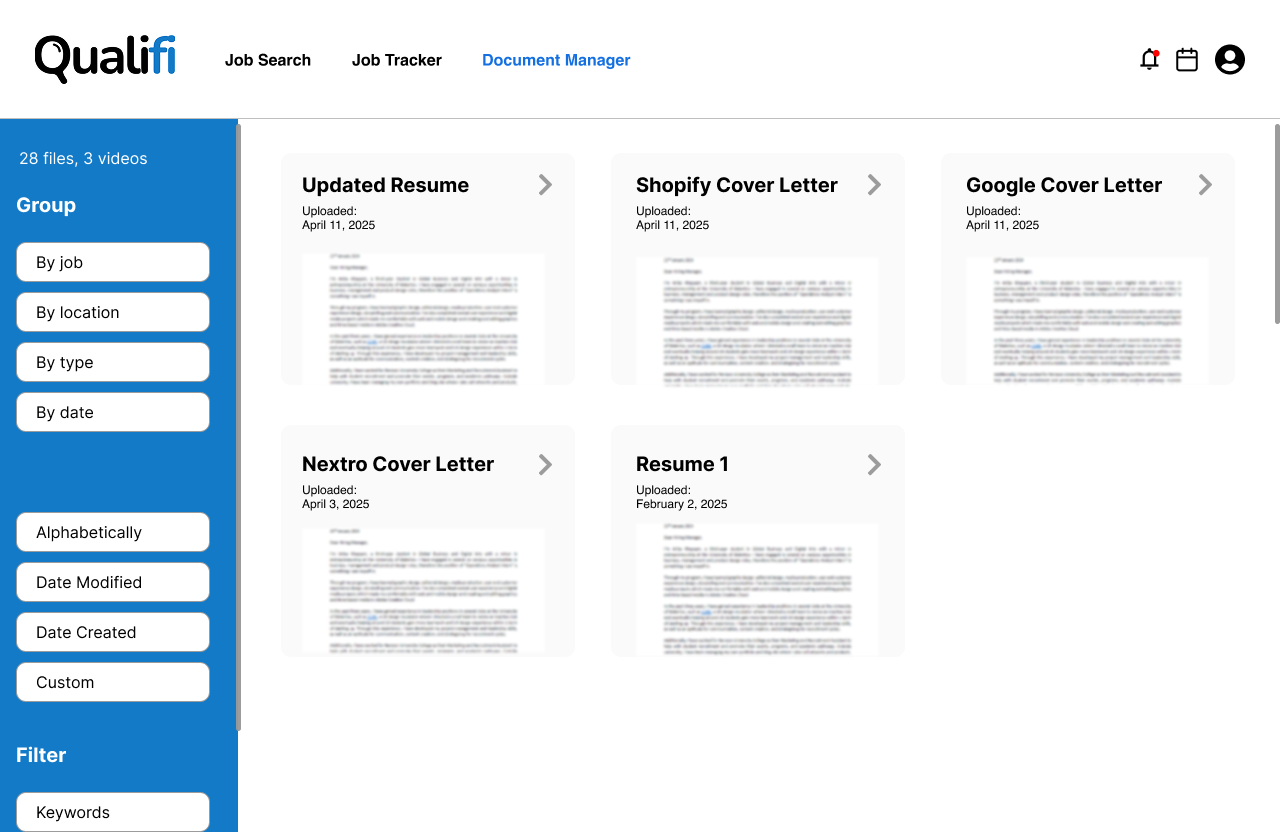
Document Manager
Allows job seekers to manage, version, and reuse their resume packages seamlessly which is a major time-saver when applying to multiple jobs.
Beyond a Website: The Qualifi Bot
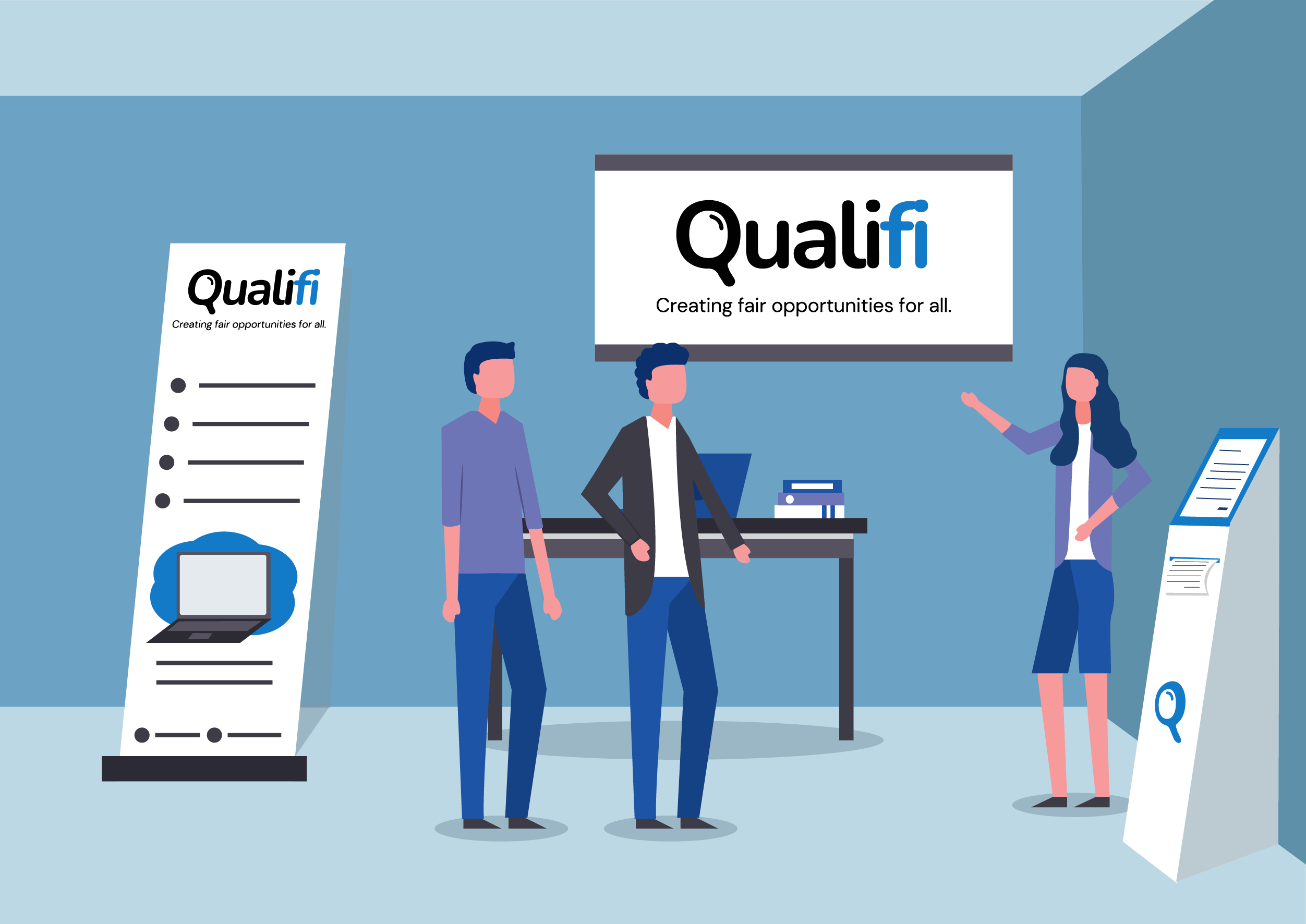
User Journey
Meet Arya, a qualified job seeker frustrated by repeated rejections despite her strong portfolio.
When Arya discovers Qualifi: She uploads her resume, which the Bias-Aware Scanner anonymizes within seconds. She uses the Cover Letter Builder to craft a version free of identifying cues.
Recruiters on the other end view only skill-based information through the Employer Dashboard.
Both parties engage with the process transparently, creating trust through clarity and fairness.
By the end of her journey, Arya applies confidently, knowing she’ll be evaluated on merit, not markers of identity.
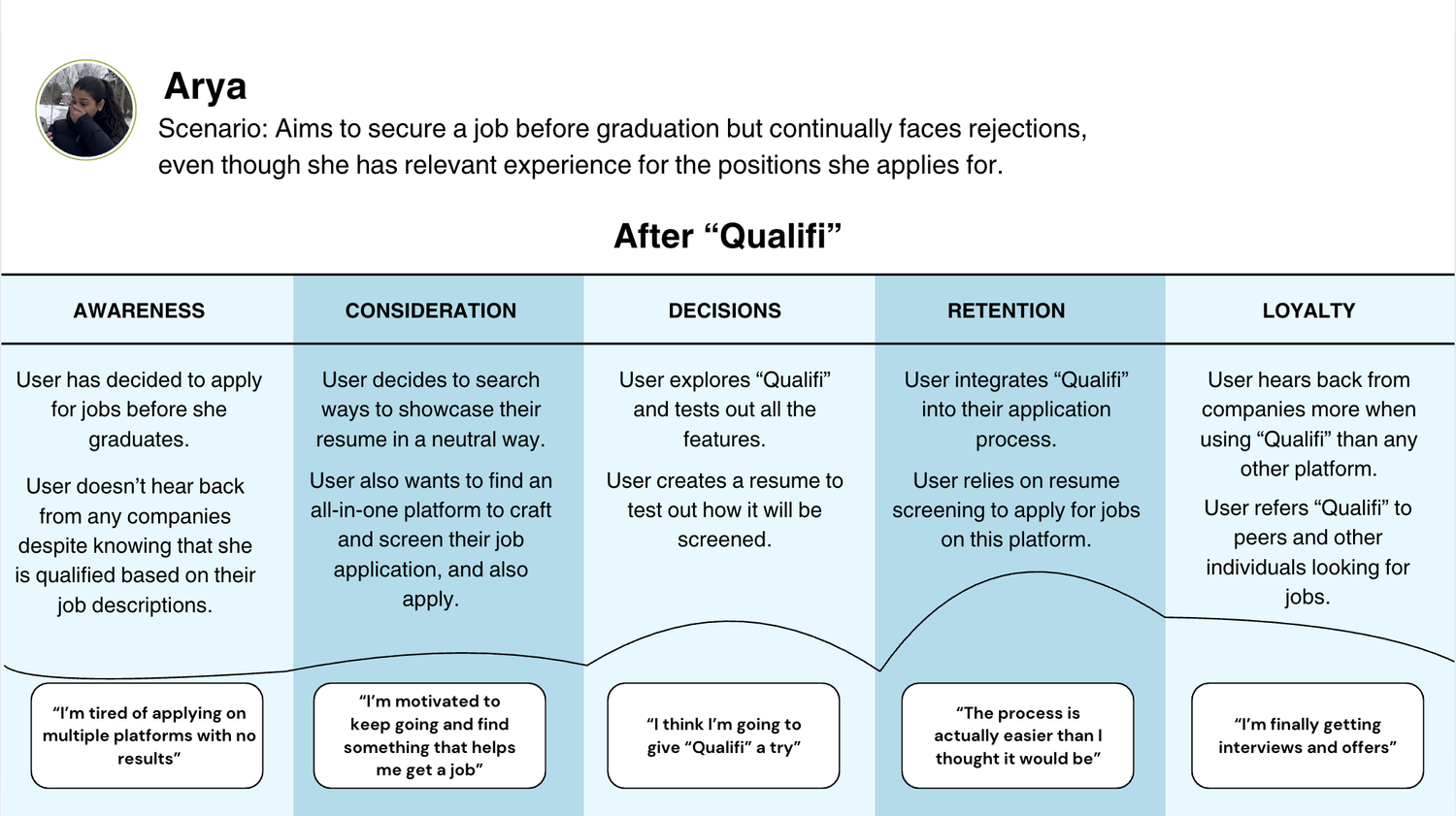
Service Design Blueprint
Our service blueprint visualized the end-to-end flow across user touchpoints, from resume uploads to interview scheduling and post-hire analytics, aligning digital and real-world interactions through one seamless experience.
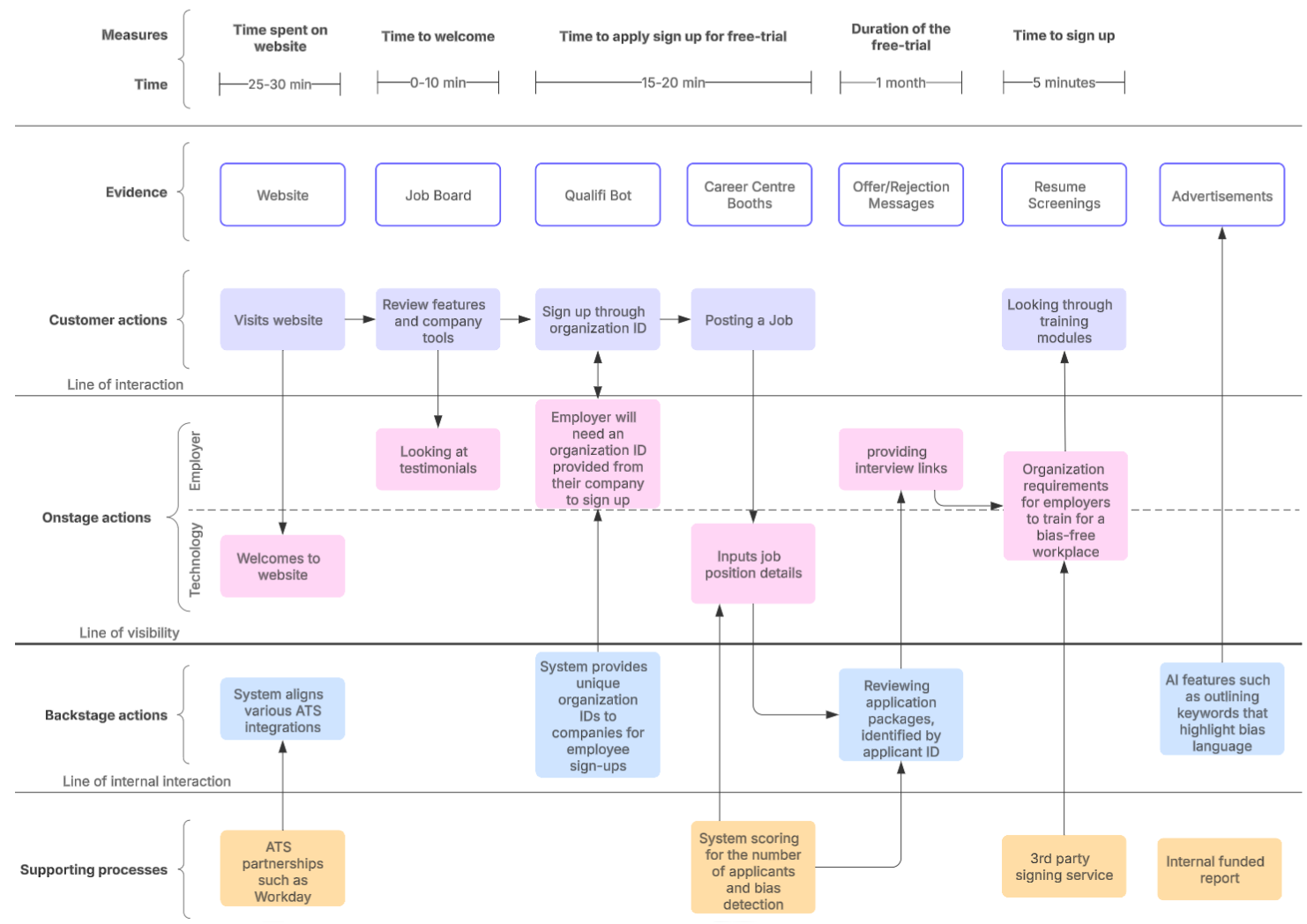
Technical Diagram
Open-source tools, modular components, and AI-driven analytics can make most of this achievable. We would ensure that the AI technology is prompted and tested enough to reduce any risks of premeditated bias. By streamlining processes and utilizing tried-and-tested tools, we aim to minimize developmental costs.

Stakeholder Map
Stakeholders were categorized by influence and interest to guide engagement strategy:
Central to design validation: (high influence-high interest)
HR managers, DEI officers, job seekers
Targeted through ROI and policy alignment: (high influence-low interest)
Executives, investors
Crucial for advocacy and adoption: (low influence-high interest)
Universities, HR tech communities
This mapping helped ensure the platform remained both user-centered and strategically sustainable.
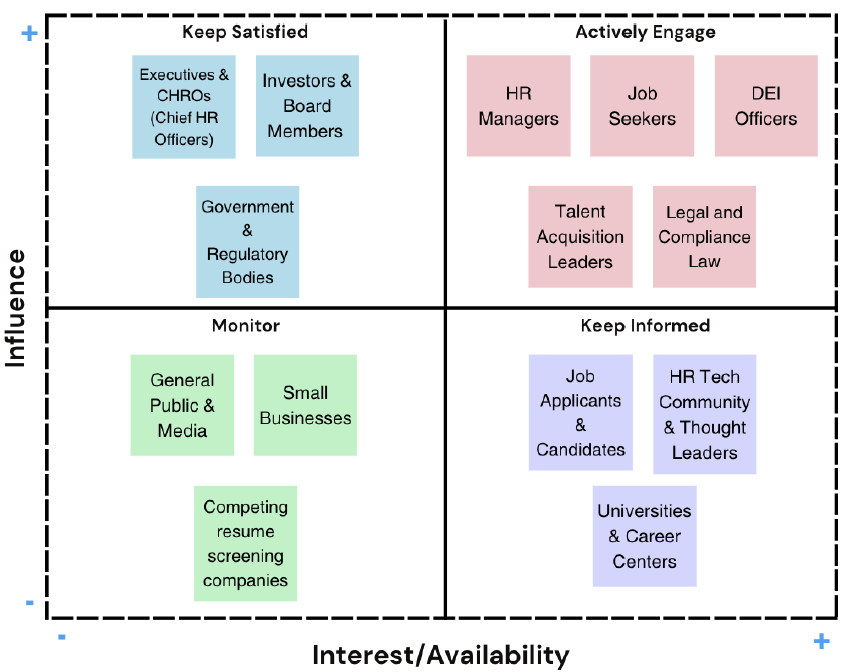
Outcome
Our timeline spans a total of 36 months, which includes product development, testing, and launch, as well as scaling and exploring global expansion.
Through multiple rounds of usability testing and mentor reviews, we observed the following results:
- 85% of participants appreciated the unified dashboard, emphasizing the value of having candidate data, resumes, and application statuses all in one place.
- 91% found the interface intuitive, requiring little to no onboarding or guidance, validating the platform’s accessible, low-friction design.
- 60% of testers (3 out of 5) initially missed the bias detection feature until prompted, indicating the need to strengthen visual hierarchy and improve feature discoverability.
- 70% of users interacted first with candidate analytics, particularly “Reviewed” and “Contacted” stats, confirming the central role of interactive insights in recruiter workflows.
- Participants described the resume tracking tool as “a real time-saver” and “exactly what I need to stay organized when hiring for multiple roles,” underscoring its practical efficiency benefits.
We designed Qualifi as a scalable SaaS platform supported by AI-driven analytics and partnerships with universities and HR tech firms. We used the information below to further understand our business model:
- Year 1: Product development and market entry
- Year 2: Scaling and market penetration
- Year 3: Global Expansion and AI evolution
- Proprietary AI and data models
- Scalable platform infrastructure
- Strong partnerships with employers and job seekers
- Training and mentorship content
- Standard Plan for Employers/Small-to-Medium Businesses: $150/month
- Enterprise Plan for Organizations: $400/month
- Enterprise Plan for Educational Institutes: $400/month
- Premium Plan for Job Seekers: $50/month